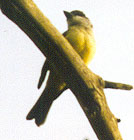 sociation.
sociation.Thick-billed Kingbird
Half Moon Bay
San Mateo County, California
1 January 1999
 opyright
© 1998 by Mike Rogers
opyright
© 1998 by Mike Rogers
Today Dan Singer, Robbie Fischer and I decided to try for the Thick-billed Kingbird which had been present at
the Ocean Colony Golf Course since December 19, 1998. It was originally found at this location on the Crystal Springs
Christmas Bird Count by Gary Deghi and Andy Kratter. Arrangements for birders to visit this private gated community
were made by Gary Deghi in conjunction with the president of the local homeowners as sociation.
sociation.
We arrived at the west end of Turnberry Road around 10am and soon I heard the bird calling loudly from a grove of eucalyptus to the west. I managed to get good but distant views through my scope (KOWA TSN-4). The bird then flew into eucalyptus closer to the road and we got better views. Finally it ended up in the cypresses right on the north side of the road and we watched it at close range as it caught several large insects from the air and in the water of a golf course pond. At times it seemed to be feeding like a kingfisher. It finally started preening actively and we were able to see many fine details through Dan's wonderful Leica APO-Televid 77 spotting scope. Unfortunately Dan's camera jammed and he was unable to obtain any photos while we were watching the bird.
The following description is based on notes taken while watching the bird:
Obvious kingbird, approximately the size of adjacent European Starling and smaller than nearby American Robin. Best located by its loud distinctive call, "prrreeeet" sharply rising.
Upperparts - back brown with slight olive cast, contrasting with a grayer nape and warmer uppertail coverts. The wings were darker brown than the back and had gray fringes to the tertials. The greater and median coverts were narrowly fringed with a light chestnut color. The innermost tertial appeared warmer brown than the rest of the tertials, older and more worn. The middle tertial appeared to be missing on both wings. The outermost tertial was a shiny dark gray color with cleaner gray fringing and appeared to be fresh.
Tail - brown above with narrow rusty edges on the outer webs of the bases of the rectrices. Gray below. The tip of the tail was paler with a light rusty cast. The central rectrices were slightly shorter than the outer, resulting in a distinct notch at the tip of the tail. Faint gray growth-bars were visible in strong light on the underside of the tail. These were angled about 45 degrees to the feather shaft, but appeared relatively even across the underside of the tail. The outermost rectrix on the left side was more worn than the other rectrices.
Head - dark crown the thick black mask through the eye. White chin and throat projecting under the dark mask to the side of the neck. The mustachial and malar area where entirely white, contrasting strongly with the black lower mandible. A thin feather crease was visible at the malar. The bill was very thick and broad, black in color, with a pale pink mouth lining. A few short, black rictal bristles could be seen but were rather inconspicuous. The culmen was slightly arched downward, especially at the tip which was hooked. There was a crease of feathers down the middle of the crown. When bathing, the bird flashed a bright yellow crown spot, which was visible on the forehead for a while during a period when the head feathers were disarranged and somewhat disheveled. In general, the crown appeared rather flat, with some slightly shaggy nape feathers.
Underparts - upper chest gray blending to bright yellow on the rest of the underparts. When preening, the wing linings at the bend of the wing could be seen to be brilliant sulfur-yellow.
Legs and feet - blackish with noticeable plates on the toes.
DISCUSSION
This is the second Thick-billed Kingbird to be found in Northern California. I was fortunate to have seen the first bird in McLaren Park, San Francisco in 1971.
 Judging from the criteria in
Identification Guide to North American Birds by Peter Pyle, this bird is SY (second calendar year, hatched last
summer) because of the rusty fringes to the rectrices and some wing coverts and the worn outer rectrices. However
the bird should not be molting tertials in January. I assume that this is an early 1st prealternate molt which
should not begin until March for a bird this age.
Judging from the criteria in
Identification Guide to North American Birds by Peter Pyle, this bird is SY (second calendar year, hatched last
summer) because of the rusty fringes to the rectrices and some wing coverts and the worn outer rectrices. However
the bird should not be molting tertials in January. I assume that this is an early 1st prealternate molt which
should not begin until March for a bird this age.
Additional details and photo by Mark Eaton can be found here.
--
Joseph Morlan
jmorlan@ccsf.org